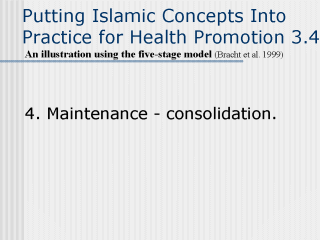| front |1 |2 |3 |4 |5 |6 |7 |8 |9 |10 |11 |12 |13 |14 |15 |16 |17 |18 |19 |20 |21 |22 |23 |24 |25 |26 |review |
 |
The theme of the
fourth stage in the Bracht et al. (1999) model is program maintenance and consolidation.
Zakat, Waqf and Saddaqa, Islamic concepts found in all the three major concepts (‘five
pillars of Islam’, Elements of Imaan-Faith’ and ‘Islamic jurisprudence’), provides
possible grounds by which health promoters can expound on in an Islamic community to
ensure sustainable health promotion interventions. In these three Islamic concepts, both
financial and other community structures in support of Islamic interests within the
Islamic society are dealt with and can be exploited to benefit health interventions. For
instance the concept of ‘Waqf’, an Islamic concept whereby able Muslims put aside
material endowments to benefit the Islamic community can be an important means for
ensuring and granting revenues for vital health promotion interventions (Hussein, 1998) Reference: Bracht, N., Kingsbury, L. & Rissel L. (1999). A Five stage Community Organization Model for Health Promotion. In Bracht, N (Ed.). Health Promotion at the community Level. (pp 83-104). International Educational and Professional Publisher, Thousand Oaks, California 91320. SAGE Publications Hussein, A. A. (1998). The art of health promotion in Islam and the contemporary public health challenges, MPH Thesis. Maastricht. University of Maastricht. |